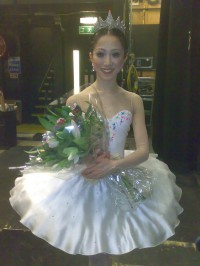
Actions speak louder than words, and this post is about an ‘action’ rather than a one-liner. It’s topical, since I happened to be swanning around at the opening night of Christopher Hampson’s Nutcracker at the Coliseum last night (thank you to Erina Takahashi for letting me snap her after the show for the blog picture).
After the last suds of G major settled after the pas de deux, I felt the familiar nausea at the thought of the impending ghastly tarantella. Everything about it is horrid, starting with the ugly timbre of the chords on bassoon and cor anglais sounding like ducks in fog, and the bass pedal (there are only two notes in the bass all the way through – B for about 20 seconds, D for another 20 seconds, and then B again until the end). It’s usually played too slow, the shifting of the beat onto the anacrusis is clever but pointless, and the inner voices add nothing except rhythmic waffle and harmonic annoyance. It’s the same feeling as I get when I get stuck behind someone trying to turn right at traffic lights.
And then, oh bliss, it never happened, because as I remembered the minute the orchestra struck up B major instead of minor, Chris had taken the brave decision long ago to ditch it in favour of the male solo from the interpolated Swan Lake pas de deux (aka ‘Tchaikovsky pas de deux’). His reasoning was that if you played the tarantella so that it sounds like a tarantella, it’s too fast for a male virtuoso solo. If you play it at a speed at which you can do steps to it, it’s no longer a tarantella. I can’t think why more people haven’t done it, it’s crying out to be removed.
At the time, I remember a few critics being sniffy about it, and I overheard someone talk very disapprovingly about the fact that he’d had it transposed into B major. It’s an odd viewpoint, considering that the tarantella itself was never written as a male solo – it was a national dance ditched from Act I and interpolated into the pas de deux, and – get this – transposed into B minor on Tchaikovsky’s instructions for exactly the same reasons as Chris transposed the other one. To try and play the ‘authenticity’ card with a ballet, even one by Tchaikovsky, is an odd game indeed in the 21st century.
It’s a small thing which shouldn’t have caused anyone to raise an eyebrow, but this is the ballet world and its prize poodle, the Nutcracker, so it took courage and artistic conviction to do it. Maybe the dance critics should award a prize for Best Cut in an Overworked Classic.

